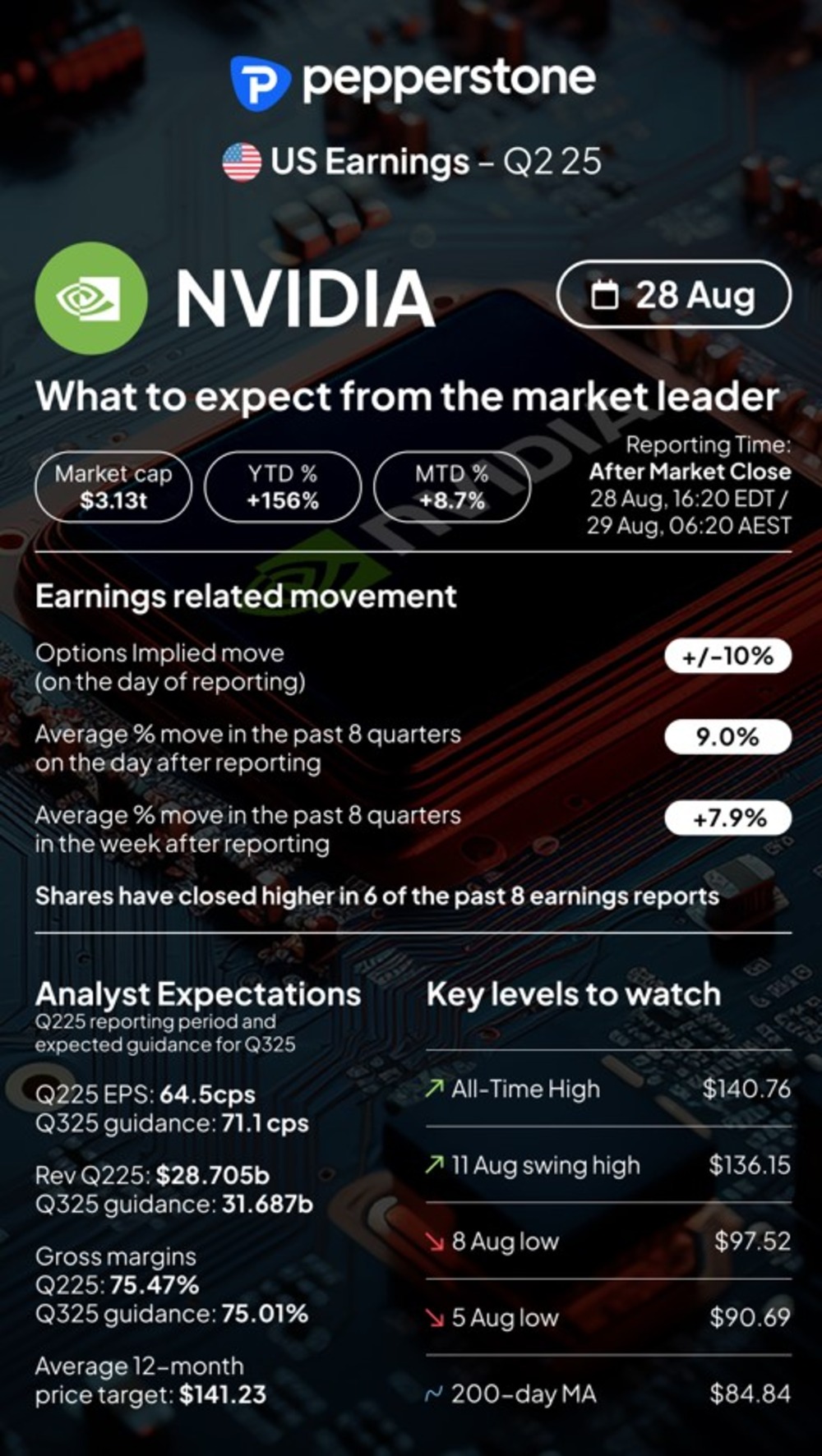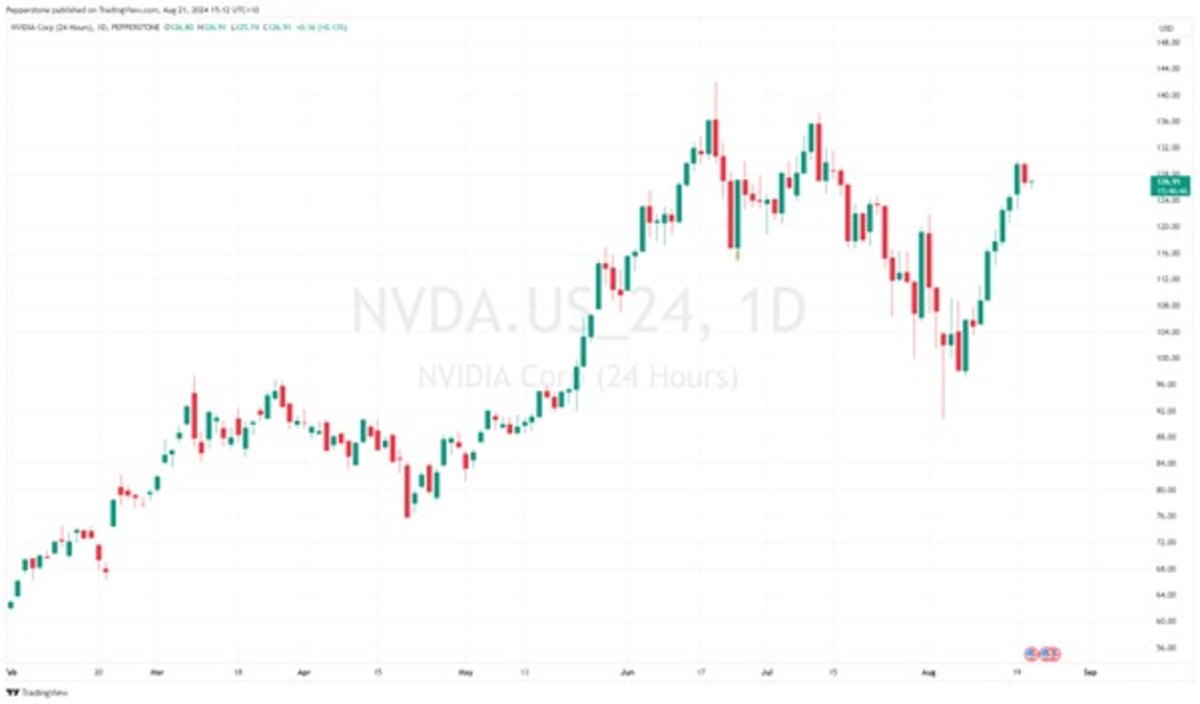- English
- 简体中文
- 繁体中文
- ไทย
- Tiếng Việt
- Español
- Português
- لغة عربية
Nvidia Q225 Earnings Preview – React with 24-hour share CFDs

When it comes to S&P500 and NAS100 company earnings, few get the sort of widespread attention that Nvidia commands from traders, investors and the media. The intense focus comes not just from those trading Nvidia’s equity but given its sizeable 7% weight on the S&P500 and NAS100, and the impact it has on other AI-rated names and semis, Nvidia can move the entire index, where sentiment can even spill over into risk FX (AUD, NZD and NOK) too.
What to expect from Nvidia’s earnings – a trader’s guide

CFD traders are mostly price-sensitive – that is, they make decisions based on price action, and technical analysis, and are drawn to markets that see more explosive movement yet have deep liquidity.
This is clearly true of Nvidia, yet while there will be an element of tactical or fundamental traders who look at the outcome of the Q225 earnings and its guidance for Q325 and assess if the business is close to peak margins, or how the Blackwell delay is likely going to impact future revenue. Arguably the majority of CFD traders see Nvidia more simplistically as an effective high beta trading vehicle - where the liquidity is excellent and where we can see explosive moves, which often exude strong underlying momentum and trend.
The question of “Why trade the S&P500, when I can trade Nvidia” is one that comes up. Of course, this comes down to the strategy and degree of risk a trader is willing to accept. But statistically, if the S&P500 rallies 1%, then Nvidia will typically gain 1.8% and will sell off 1.8% if the S&P500 falls 1%. If Nvidia are so influential on the index, trades 24 hours a day, but has greater movement, then some see Nvidia as an alternative to trading the index.
Nvidia - The current setup on the daily chart

The flexibility to trade any direction view – Long or short
With Pepperstone’s 24-hour Nvidia CFDs, CFD traders can trade Nvidia long and short, which offers the flexibility to express any directional view, with a hold time of their choosing. So if they feel there is a high probability Nvidia disappoint the lofty consensus expectations for earnings and what’s priced into its valuation, then they may look to position short into the earnings, in the hope that the share price declines.
Conversely, some may consider the impressive form guide, where Nvidia typically always beats expectations, with CEO Jensen Huang inspiring and hitting the market sweet spot, then they may look to take long positions in Nvidia into earnings.
With the options market implying a move of 10% on the day of earnings, there is a risk that we could see an immediate spike in the share price (up or down) once the earnings and guidance break - so if not in an open position before the outcome is known, then it can be a challenge to trade the initial reaction.
Scalping price moves in Nvidia
Those who don’t have a view on whether Nvidia disappoints/pleases expectations should consider that the price action in the 30 minutes after earnings and the CEO call could be very lively. It’s here where algorithms rapidly react to certain keywords and changes in sentiment, while hedges are unwound, and organic order flows become significant upon hearing the facts.
This type of rapid movement may be a hunting ground for the ultra-short-term scalpers, and at 2c a share and no minimum clip, scalpers can look at Pepperstone US equity CFDs with as a cost-effective vehicle for discretionary or EA scalping strategies.
Big movement could lead to momentum and trend
For those whose strategy is deployed in the higher timeframes – 1-to-4-hour bars – then given the expected movement, the post-market session may offer momentum and even trending conditions, and a strong environment to react to the flows and the price action that presents itself to traders.
It goes without saying that there will be a huge focus on Nvidia’s earnings – it could get very lively on both Nvidia’s equity, as well as the broader market. You may want to consider putting Nvidia’s 24-hour share CFDs on your radar.
For more information on trading Nvidia, click here 24-hour share CFDs.
The material provided here has not been prepared in accordance with legal requirements designed to promote the independence of investment research and as such is considered to be a marketing communication. Whilst it is not subject to any prohibition on dealing ahead of the dissemination of investment research we will not seek to take any advantage before providing it to our clients.
Pepperstone doesn’t represent that the material provided here is accurate, current or complete, and therefore shouldn’t be relied upon as such. The information, whether from a third party or not, isn’t to be considered as a recommendation; or an offer to buy or sell; or the solicitation of an offer to buy or sell any security, financial product or instrument; or to participate in any particular trading strategy. It does not take into account readers’ financial situation or investment objectives. We advise any readers of this content to seek their own advice. Without the approval of Pepperstone, reproduction or redistribution of this information isn’t permitted.